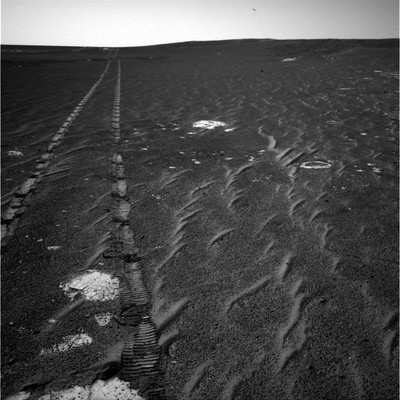It Just Keeps Going, And Going... And GOING...
Attention, anyone who may have written off NASA's Mars
Exploration rover Opportunity -- designed to last a mere 90 days on
the Martian surface -- at anytime over the past... sheesh,
54 months.

The Little Rover That Could has shaken off everything from
Martian dust storms, to power spikes and balky arms -- even an
extremely ill-considered NASA budget cutback
proposal -- and is now heading back out to the Red
Planet's surrounding plains nearly a year after descending into a
large crater to examine exposed ancient rock layers.
"We've done everything we entered Victoria Crater to do and
more," said Bruce Banerdt, of NASA's Jet Propulsion Laboratory in
Pasadena, CA. Banerdt is project scientist for Opportunity and its
rover twin, Spirit.
Having completed its job in the crater, Opportunity is now
preparing to inspect loose cobbles on the plains. Some of these
rocks, approximately fist-size and larger, were thrown long
distances when objects hitting Mars blasted craters deeper than
Victoria into the Red Planet. Opportunity has driven past scores of
cobbles but examined only a few.

"Our experience tells us there's lots of diversity among the
cobbles," said Scott McLennan of the State University of New York,
Stony Brook. McLennan is a long-term planning leader for the rover
science team. "We want to get a better characterization of them. A
statistical sampling from examining more of them will be important
for understanding the geology of the area."
Opportunity entered Victoria Crater on September 11, 2007, after
a year of scouting from the rim. Once a drivable inner slope was
identified, the rover used contact instruments on its robotic arm
to inspect the composition and textures of accessible layers.
The rover then drove close to the base of a cliff called "Cape
Verde," part of the crater rim, to capture detailed images of a
stack of layers 6 meters (20 feet) tall. The information
Opportunity has returned about the layers in Victoria suggest the
sediments were deposited by wind and then altered by
groundwater.
"The patterns broadly resemble what we saw at the smaller
craters Opportunity explored earlier," McLennan said. "By looking
deeper into the layering, we are looking farther back in time." The
crater stretches approximately 800 meters (half a mile) in diameter
and is deeper than any other seen by Opportunity.
Engineers are programming Opportunity to climb out of the crater
at the same place it entered. A spike in electric current drawn by
the rover's left front wheel last month quickly settled discussions
about whether to keep trying to edge even closer to the base of
Cape Verde on a steep slope. The spike resembled one seen on Spirit
when that rover lost the use of its right front wheel in 2006.
 Opportunity's six wheels are all still working after 10 times
more use than they were designed to perform, but the team took the
spike in current as a reminder that one could quit.
Opportunity's six wheels are all still working after 10 times
more use than they were designed to perform, but the team took the
spike in current as a reminder that one could quit.
"If Opportunity were driving with only five wheels, like Spirit,
it probably would never get out of Victoria Crater," said JPL's
Bill Nelson, a rover mission manager. "We also know from experience
with Spirit that if Opportunity were to lose the use of a wheel
after it is out on the level ground, mobility should not be a
problem."
Opportunity now drives with its robotic arm out of the stowed
position. A shoulder motor has degraded over the years to the point
where the rover team chose not to risk having it stop working while
the arm is stowed on a hook. If the motor were to stop working with
the arm unstowed, the arm would remain usable.
Spirit has resumed observations after surviving the harshest
weeks of southern Martian winter. The rover won't move from its
winter haven until the amount of solar energy available to it
increases a few months from now. The rover has completed half of a
full-circle color panorama from its sun-facing location on the
north edge of a low plateau called "Home Plate."

"Both rovers show signs of aging, but they are both still
capable of exciting exploration and scientific discovery," said
JPL's John Callas, project manager for Spirit and Opportunity.
The team's plan for future months is to drive Spirit south of
Home Plate to an area where the rover last year found some bright,
silica-rich soil. This could be possible evidence of effects of hot
water.
Both rovers arrived at the red planet within weeks of each other
in January 2004. The rovers were originally supposed to last a mere
90 days.
 ANN's Daily Aero-Linx (04.13.24)
ANN's Daily Aero-Linx (04.13.24) ANN's Daily Aero-Term (04.13.24): Beyond Visual Line Of Sight (BVLOS)
ANN's Daily Aero-Term (04.13.24): Beyond Visual Line Of Sight (BVLOS) Airborne 04.09.24: SnF24!, Piper-DeltaHawk!, Fisher Update, Junkers
Airborne 04.09.24: SnF24!, Piper-DeltaHawk!, Fisher Update, Junkers Aero-News: Quote of the Day (04.14.24)
Aero-News: Quote of the Day (04.14.24) ANN's Daily Aero-Term (04.14.24): Maximum Authorized Altitude
ANN's Daily Aero-Term (04.14.24): Maximum Authorized Altitude





